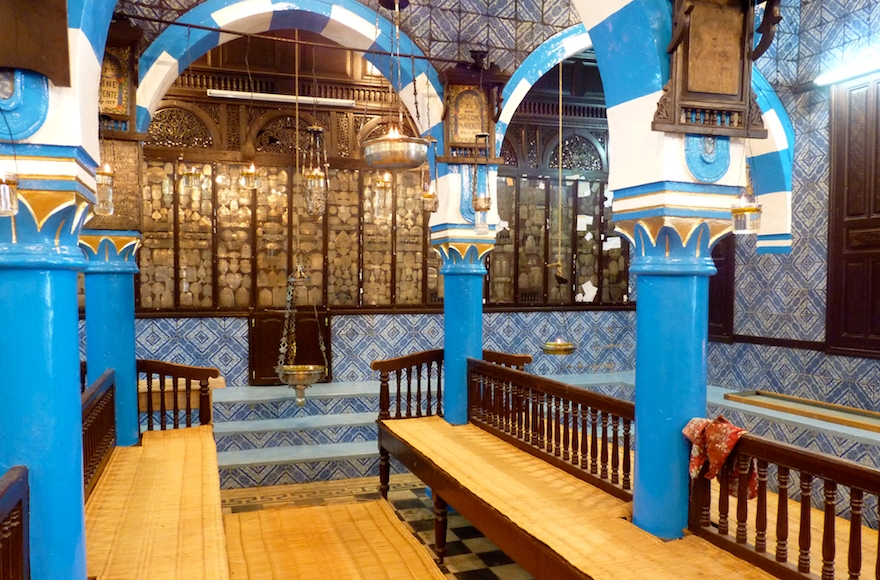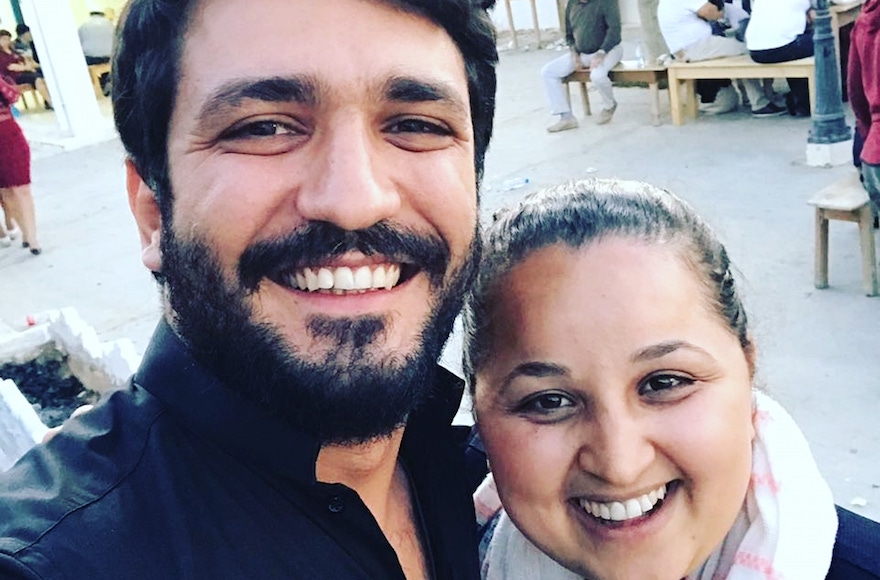A French Muslim woman reflects on her visit with Tunisia’s tiny Jewish community
Published May 9, 2018

A view of the ceremony after the Pilgrimage of the Ghriba on the Tunisian island of Djerba. (Samia Hathroubi)
DJERBA, Tunisia (JTA) — El Ghriba, the venerable synagogue on the Tunisian island of Djerba, is traditionally described as a place of miracles. The Arabic term for the shrine, Gharaba, can also be translated as wonders.
ADVERTISEMENT
Miracles and wonders happened to me on May 3-4 when I took part in the annual Pilgrimage of the Ghriba, held every year on Lag b’Omer.
I am a French Muslim woman of Tunisian origins, who has devoted my life to building ties of communication and cooperation between Muslims and Jews in Europe, Israel-Palestine and in Muslim countries like Morocco and my homeland of Tunisia. During a four-year tenure as European director of the Foundation for Ethnic Understanding, which ended last year, I organized several Muslim-Jewish twinning events in Tunis commemorating the history of Jews in my homeland, including several commemorations of the Holocaust which drew the participation of important Tunisian political leaders.
However, my most recent trip to Djerba was not about history, even though the origins of the Ghriba may go back to 586 B.C., when Israelites escaping the destruction of the First Temple are said to have sailed all the way to this island in the Mediterranean to start life anew. No, I felt my participation in this event was not about ancient times, but about life as lived in the recent past and the present. For the first time in my own life, I witnessed what Tunisia must have been like before the departure of of nearly all of its Jews. For two precious days, I was able to envision what coexistence and shared sacred place must have meant for Tunisian Jews and Muslims, who lived together for hundreds of years, for the most part in friendship and peace.
(My attendance on the pilgrimage was sponsored by FFEU as part of its efforts to promote Muslim-Jewish dialogue in Europe and North Africa.)
Participating in the Ghriba Pilgrimage was also a unique opportunity to witness what was one of the central annual events of the Tunisian Jewish community for centuries. More than 350,000 Jews lived here before they began leaving en masse in 1956 for France, Israel and other locales. Today between 1,500 and 2,000 Jews remain in Tunisia, with a small community of about 400 in the capital city of Tunis and most of the remainder on Djerba, where Haim Bittan, the Chief Rabbi of Tunisia, lives. The Ghriba is located in the town of Riadh in the Harra Seghira, one of two Jewish neighborhoods on the island.

The main prayer hall of the El Ghriba Synagogue on the Tunisian island of Djerba. (Wikimedia Commons)
ADVERTISEMENT
Arriving early on Wednesday, May 3, just as the pilgrimage was beginning, I could not help but notice the massive presence of the Tunisian army and police, who were there to protect the pilgrims. Indeed, it is impossible to to arrive on the island by air or by the short bridge connecting it to the Tunisian mainland without passing through multiple inspections. Ever since a terrorist bombing of the Ghriba synagogue in 2002 that left 19 dead and more than 30 wounded, enhanced security has been a constant here. The level of protection was stepped up even further in the past several years after bloody terrorist attacks at the National Museum in Tunis and on a hotel on the Mediterranean shore catering to European tourists.
The present-day Tunisian government is a coalition between the moderate Islamist movement Ennadha and the Nidha Tounes center-right political movement built by one-time supporters of Zine El Abidine, the dictator overthrown in 2010 in the first act of the Arab Spring. It fully understands that tourists will not come back to the country, which is beset by a severe economic depression and desperately needs tourism revenue, unless it prevents terrorism and avoids slipping into chaos like its neighbor Libya, which is located only an hour’s drive from Djerba.
Before heading to the tight-knit Jewish neighborhood of Harra Seghira, I visited the Homt Souq, a bazaar in the center of the island. Among the myriad souvenir shops, I visited the Bittan jewelry shop, where I was greeted warmly by two prominent Jewish residents of Djerba, Nessim Bittan and his son Mehir. Their shop is an institution in the island where both Jewish and Muslim customers shop for jewelry, and where you can find menorahs, mezuzahs or yads, the pointers used to read from the Torah scroll. Like many other Jewish Djerban families, the Bittans were looking forward to joining the annual festival that afternoon after work. This year, they were optimistic about its success.
“Finally people are back, and it is going to be a good year,” Mehir Bittan told me.
Mehir’s prediction turned out to be correct. According to Rene Trabelsi, a Paris-based Tunisian-Jewish businessman and tour operator who has brought visitors to the event for 30 years, more than 6,000 visitors came for the 2018 Lag b’Omer pilgrimage, mainly from France and Israel. Indeed, four hotels on Djerba were fully booked for the Israeli visitors. Trabelsi told me that this year’s total was 2,000 more than last year and the best year since the Arab Spring. The vast majority of the pilgrims are former Tunisian Jews who emigrated to France and Israel and their descendants.
Before entering the Jewish quarter, I had to go through multiple check-points where Tunisian police checked my papers, invitation and bags.

Samia Hathroubi, right, with Moshe Uzan, assistant to the chief rabbi of Tunisia. (Samia Hathroubi)
Inside, the Ghriba synagogue and many other venerable stone buildings were all festooned in white and blue for the occasion. The alley in the very heart of the Harra was already packed. To the left I saw the ancient but humble looking synagogue, and to my right, in a small square, an orchestra composed of both Muslim and Jewish residents of Djerba playing traditional Tunisian songs. Pilgrims sang, danced and clapped enthusiastically, many with tears in their eyes. As I wandered away from the central square, I found myriad kiosks and booths selling food, souvenirs and beverages. Bukha, a local fig liquor, was ubiquitous, no doubt adding to the festive atmosphere.
As in other recent visits to the Jews of Tunisia, my guide in Djerba was my dear friend Moshe Uzan, assistant to the chief rabbi of Tunisia. Moshe, who was born and raised in Tunis, less than a 10-minute walk from my family’s ancestral home, was the first one to guide me through the streets of Tunis to help me discover remnants of Jewish life I had never noticed before. Since our first encounter three years ago, our relationship has been one of a profound sense of connection. I was born and raised in France of Tunisian Muslim parents who taught me about the Jews they had known in Tunis, where Moshe was born, raised and still lives. Standing side by side together, at the Ghriba, I felt that Moshe and I were writing a new chapter of Muslim-Jewish coexistence in Tunisia.

Jewish Tunisians speaking in the Ghriba. (Samia Hathroubi)
Entering the synagogue, Moshe led me to the holiest spot in the ancient center of the Ghriba, where women cover their hair and where all visitors must take off their shoes, as in a mosque. It felt to me profoundly like home. According to tradition, this sacred place was founded in 586 B.C., and built by stones brought by the Jewish diaspora after the destruction of the First Temple by the Babylonian king Nebuchadnezzar. There is a time-out-of-mind quality about the place that is quite overpowering.
I saw people praying and pressing their heads against the wall while clutching the Sefer Torah. Men and women lit candles. A woman sat nearby, holding a carton containing six eggs. This is a unique tradition of the Ghriba: Jewish and Muslim women come before their weddings or when they are hoping to become pregnant to write their wishes and prayers on eggs, and place them in a niche at the heart of the synagogue.
Sawssen was one of them. Dressed in a traditional Berber wedding costume and wearing a white veil, she took selfies while lighting candles and placed two eggs in the wall. She lives in the neighborhood and is Muslim. When I ask her why she came, she seemed to be surprised by my question.
“I have always lived here next to the Harra,” she replied. “The Ghriba is as holy for me as it is for my Jewish neighbors.”

A Muslim woman taking a selfie in the Ghriba’s holy shrine. (Samia Hathroubi)
Doriana, a Tunisian-Jewish woman now living in Israel, looked surprised and delighted to see two Muslim women taking part in the Pilgrimage. After a 23-year absence, she had came back to the Ghriba with her brother, nephew and sisters in law. She explained to me that seven years after the Tunisian Revolution of 2010, the family felt secure and safe enough to come back and enjoy traditional Tunisian dishes like brik, a stuffed pastry; pkeila, a beef and couscous casserole; and sweet yoyo doughnuts.
After official words of greeting and speeches by the chief rabbi, Tunisian Prime Minister Youssef Chahed, Minister of Tourism Selma Elloumi Rekik and, significantly, the Minister of Religious Affairs from Ennadha, the Islamist party, there was an exuberant reception. Visitors mingled in a babel of Tunisian-accented Arabic, Berber languages, French and Hebrew. Among the guests were the ambassadors of France, Morocco and the United States, together with distinguished rabbis from Paris, Nice and other places.
Sharing a meal of brik with French Ambassador to Tunisia Olivier Poivre d’Arvor, I discussed with him the future of the Jewish Tunisian museum, a project that was launched during the 2017 Ghriba Pilgrimage and is coordinated by a scientific committee headed by Lucette Valensi, a French-Tunisian Jewish historian. Like many projects launched after the Revolution, the project will take time to become reality.
To be honest, I am not overly eager to see this project come to fruition. I don’t want my children, my family to discover the Jewish heritage of my native land of Tunisia through a museum. Museums belong to the past. I am all too aware that my friends Moshe Uzan and Nissim and Mehir Bittan are among the very few Jews who continue to live in Tunisia, with the great majority having left for France and Israel decades ago. Still, I wish that Tunisia’s small Jewish community will survive and thrive and that their precious heritage, very much including the sacred Ghriba and this magical pilgrimage, will pass on to future generations.
As René Trabelsi said to me at the conclusion of the Lag b’Omer Pilgrimage, “The Ghriba is unique. It is a Jewish pilgrimage in an Arab and a Muslim country that is also democratic. Everyone should take part in this event at least once in their lives.”
I couldn’t agree more. I’m already thinking about L’shanah haba b’Djerba — next year in Djerba.















